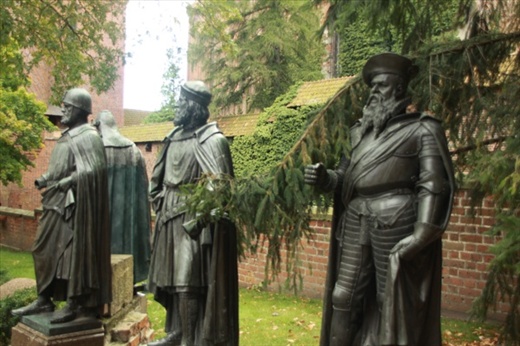The German couple fidgeted and looked up the track expectantly. The train that would take us from Gdansk to Malbork was late, unheard of and unacceptable across the border in their country. With my "schlectes Deutsch" and his marginally better English we compared travel stories. They, too, have been working their way through the Baltics from Scandinavia and, I think, St. Petersburg. A few years ago, the years seem to run together for them too, they walked the pilgrimage route to Santiago de Campostela in Spain. We got separated once the train arrived and never saw them again. Good travels!
We made several stops in the next 90 minutes but none of the stations were announced ahead of time; often we didn't know the name of the town until we were pulling out again. But you can hardly miss Malbork. The tracks run near the castle, one of the largest and most famous in Europe, and our first World Heritage Site in Poland. A short taxi ride brought us to our hotel, actually a hybrid hotel/hostel, a small, clean, en-suite room with a communal kitchen - $31 and a million dollar view.

Herman, Siegfried, Winrych and Albrecht, Grand Masters
Malbork Castle, or Marienburg, is actually three castles, with the oldest (and most interesting) in the center, 21 hectares (50 acres) in all. Construction was begun in the 13th Century and Malbork served as the headquarters for the Order of Teutonic Knights. It was as much a religous convent as a castle with knights sallying out on Crusades to Christianize the Lithuanians. Statues of some of the Grand Masters from 1209 to 1525 stand guard in the courtyard, luminaries like Herman von Salza, Siegfried von Feuchtwangen, Winrych von Kniprode and Albrecht Hohenzollern.

Malbork in 1945 (archival photo)
Malbord was heavily damaged during WW II by, I assume, poorly aimed bombs intended for the nearby railway bridge. The castle could have had no strategic importance other than the cultural value the Germans placed upon it. Much restoration work has been,and continues to be done. Conservators diligently research each room as they determne its function in the original building. They are rethiknking some, like the "Refrectory," which now appears to have been something else. It's probably this careful examination that helped get WHS status to a site where so little of the original remains. One area under consideration is the St. Marys Church where they are debating whether to restore it to its previous state or leave it as is - another reminder of what war ultimatley deprives us of.